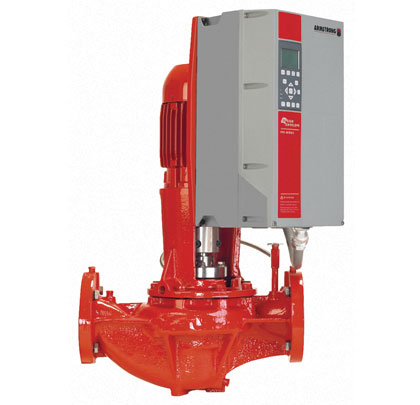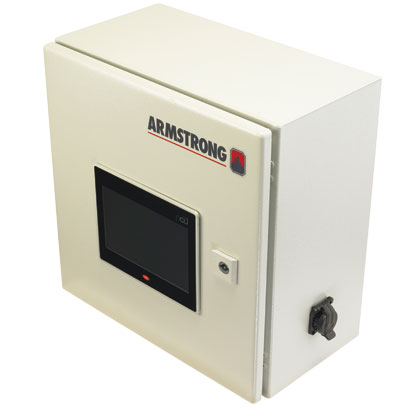The engineers and technicians at Armstrong Fluid Technology listen to client needs and pay attention to their circumstances. In the first example, the Armstrong Opti-Visor™, a chilled water plant control solution that provides optimized control advice to system components, tackles the demanding cooling job. Through a data exchange with the building automation system (BAS) the Opti-Visor™ raises plant performance to ultra-efficient levels.
In the second study, Armstrong Design Envelope solutions, integrated with custom-designed geothermal systems, deliver energy efficiency to boost performance beyond regulation standards. Both case studies highlight the range of efficiency options customers have at their disposal when embracing integrated solutions.

A UNIQUE PROBLEM
Data centers operate in a highly competitive industry, where performance metrics such as uptime are of paramount importance. A datacenter is also a very expensive facility to operate, with equipment cooling requirements that account for a large percentage of overall costs.
Setpoint Systems Corporation is a controls contractor operating in the United States, primarily in the Midwestern states. In late 2011, Setpoint approached Armstrong for assistance in improving the cooling efficiency of a data center for a prominent online retailer. Setpoint and Armstrong determined that the customer could improve HVAC efficiencies and reduce their energy costs. It was estimated that they could reach an efficiency level of 0.45 kilowatts per ton.
The existing system already included an industry-standard BAS, with installed sensors. Based on a review of the equipment and control systems installed, and discussions with the customer to understand their requirements, Armstrong recommended installation of an Opti-Visor™. The Armstrong Opti-Visor™ is a chiller plant control solution that’s compatible with a host of industry-standard BAS systems. Linked to the BAS network, the Opti-Visor™ receives chiller plant operating data, determines the optimal equipment settings and communicates these optimal settings to the BAS.

A KEY CHALLENGE IN INSTALLATION
One key challenge around the installation involved the timing. Armstrong and Setpoint had to be certain to avoid the Christmas season, and that allowed only a very limited window of time for installation. Another challenge involved the calculation of efficiencies for the installed HVAC components. No records were available concerning the performance characteristics of the existing chillers.
To address the issue of performance characteristics, Armstrong generated operating parameters using estimates drawn from industry defaults, and created the required performance profile for the Opti-Visor™ settings.
Installation and commissioning was scheduled for the first week of January 2012. With Armstrong providing technical support as needed, Setpoint completed the work in just three days.
OPTI-VISOR BENEFITS
Examining the operating data after the installation, it turned out that the calculated operating points for the control curves were extremely accurate. As a result of the accuracy and performance of the Opti-Visor™, the installation improved the HVAC efficiency to 0.38 kilowatt per ton—15 percent better than the original estimate.
With this efficiency improvement, the retrofit project was cash-positive within two months and the savings continue to accumulate. Both Setpoint Systems and their customer were understandably delighted with the results.

A SOLUTION AT THE HEAD OF THE CLASS
The University of Ontario Institute of Technology (UOIT) is a unique learning facility brought to life through an integrated design process and a sustainable design agenda. From the outset, the vision for this project was to create one of the most sustainable campuses in Canada. Diamond and Schmitt Architects were asked to develop the campus plan and the designs for six new buildings. Mutual Mechanical of Oshawa, Ontario, was in charge of the HVAC installation.
Throughout the design process both UOIT and the Diamond and Schmitt design team were focused on the following objectives:
- A vital, sustainable campus landscape
- Modularity and flexibility of the system
- Energy efficiency 50 percent better than the model National Energy Code
- Water conservation and storm water management
- Universal connectivity
Diamond and Schmitt incorporated a number of advanced features into the buildings, including green roofs, coated windows and an innovative geothermal system linking each building to a central HVAC plant and a well-field. Armstrong was offered the opportunity to contribute pumping technology to the geothermal installation.
The UOIT installation is one of the largest geothermal well fields in North America with over 380 bore holes (700 feet [213 meters] deep) that are used to heat and cool the campus buildings. Glycol solution circulates through the underground network. In the winter, the geothermal system takes heat from the earth, and carries it to the buildings.
Asked about the success of the installation, Jim Metro of Mutal Mechanical replies, “Managers and maintenance staff from UOIT are delighted with the performance and reliability of the Armstrong equipment.”
In the summer, the same system removes heat from the buildings and disperses it into the ground. Because of their expanded performance range and partload efficiency, Armstrong Design Envelope pumps and heat exchangers are ideal for this type of installation. ■
_________________________________________________________________________
ABOUT THE AUTHOR
Brent Ross is the director of configured equipment for Armstrong Fluid Technology. For more information about Armstrong’s full line of solutions, visit www.armstrongpumps.com.
_________________________________________________________________________
MODERN PUMPING TODAY, December 2013
Did you enjoy this article?
Subscribe to the FREE Digital Edition of Modern Pumping Today Magazine!
![]()


